With the rise of modern interior design, many options exist for displaying art and photos in fresh, engaging ways. Among the most popular display choices today are acrylic and canvas prints—each offering unique ways to showcase your artwork, but they serve different purposes and create distinct visual effects.
While canvas prints offer a timeless, artistic feel, acrylic prints deliver a modern, high-impact look that’s catching the eye of many photographers and home decorators.
Picking the right type can significantly affect the visual impact, durability, and even maintenance needs of your artwork. This guide will help you make an informed decision by covering each print type’s advantages, disadvantages, and ideal settings.
Quick Comparison
For a quick overview, here’s a comparison chart:
| Feature | Acrylic Prints | Canvas Prints |
| Visual Effect | Glossy, vibrant, highly detailed | Textured, painterly, softer finish |
| Durability | High; scratch-resistant, long-lasting colors | Medium; can be prone to scratches, some fading |
| Best Uses | Modern, sleek interiors | Classic, cozy, rustic settings |
| Price Range | Higher than canvas, depending on size | Moderate and more budget-friendly |
| Maintenance | Wipes clean, but prone to fingerprints | Requires careful handling |
Key Differences Summary
Acrylic prints excel in vibrant color and crisp details, making them ideal for modern settings and highly detailed images. With their painterly finish, canvas prints offer a cozy, classic appeal perfect for textured images and traditional styles.
Quick Decision Guide
- Choose Acrylic Prints for a modern, glassy look with solid colors.
- Choose Canvas Prints if you prefer a softer, more traditional aesthetic with subtle texture.
Defining Canvas and Acrylic Prints
Here’s an overview of the characteristics of these wall decor materials and their pros and cons.
What Are Canvas Prints?
Canvas prints involve printing an image onto canvas fabric, then stretched over a frame. The texture of the canvas adds depth to the print, giving it a classic, painterly look.
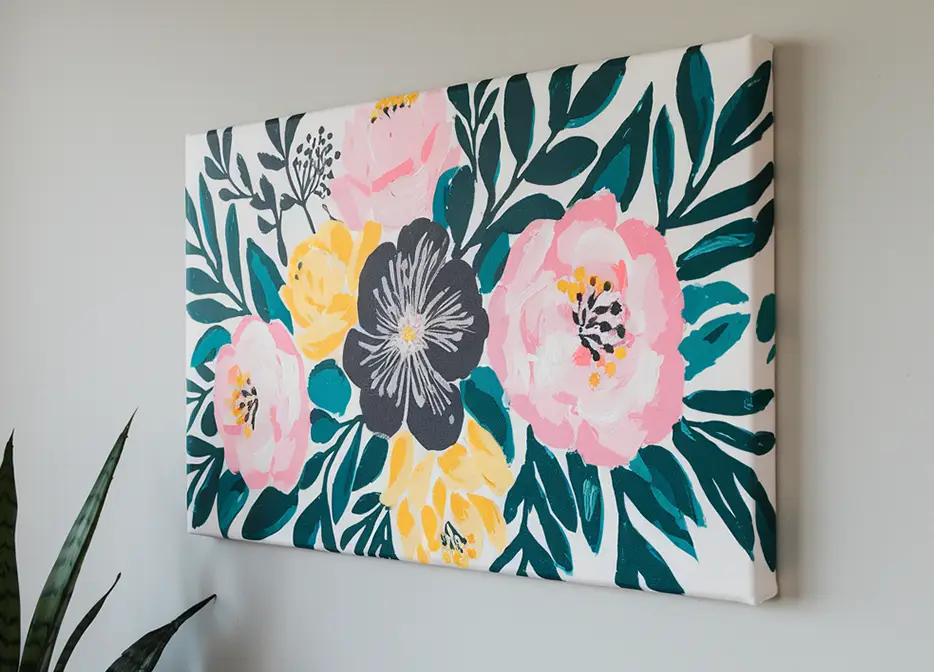
Manufacturing Methods
- Giclée Printing: This technique uses high-quality inkjet printers to spray the image onto the canvas, ensuring vibrant color accuracy and durability.
- Canvas Stretching: After printing, the canvas is stretched onto a frame, which creates a taut, ready-to-hang product.
Canvas Material Types
Typically, canvas is made of either cotton or polyester, each with slightly different textures and durability levels.
Pros and Cons
- Pros: Affordable, lightweight, minimal glare, textured finish, multiple size and framing options.
- Cons: Susceptible to scratches, needs gentle cleaning, colors may fade over time without UV protection.
What Are Acrylic Prints?
Acrylic prints are created by printing an image onto photographic paper, then mounting it onto an acrylic sheet. This method gives the print a glossy, almost three-dimensional effect.
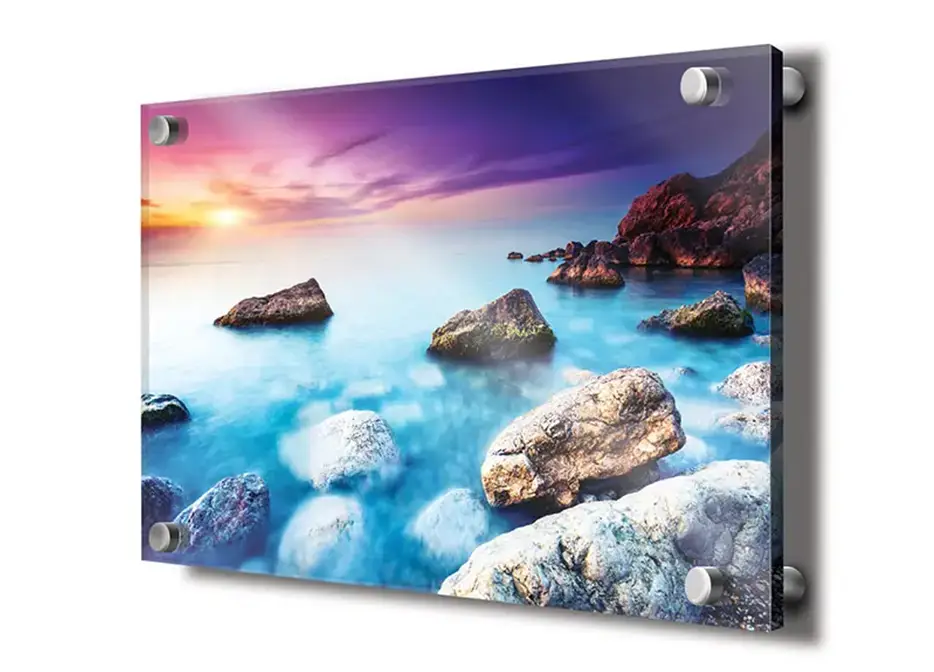
Manufacturing Methods
- Direct Printing: The image is printed directly onto the back of the acrylic sheet. This process is efficient and creates vibrant colors.
- Face-Mounting Technique: The print is created on photo paper and then face-mounted to an acrylic sheet. This method produces exceptionally sharp images but often costs more due to labor and materials.
Material Characteristics
Acrylic is a durable material resistant to UV light, which keeps colors vibrant longer. However, it’s prone to glare and quickly shows fingerprints.
Pros and Cons
- Pros: Excellent color vibrancy, sharp details, modern look, long-lasting.
- Cons: Susceptible to glare, can scratch, higher cost.
Visual Quality Comparison
Style and Visual Impact
Acrylic and canvas prints bring a distinct style and impact to a room, shaping the viewer’s experience. Acrylic prints stand out with their sleek, modern appeal. The glossy surface adds a glass-like sheen, enhancing color brightness and depth, making them ideal for contemporary spaces. This bold look emphasizes sharpness and vibrancy, creating a striking effect that commands attention.
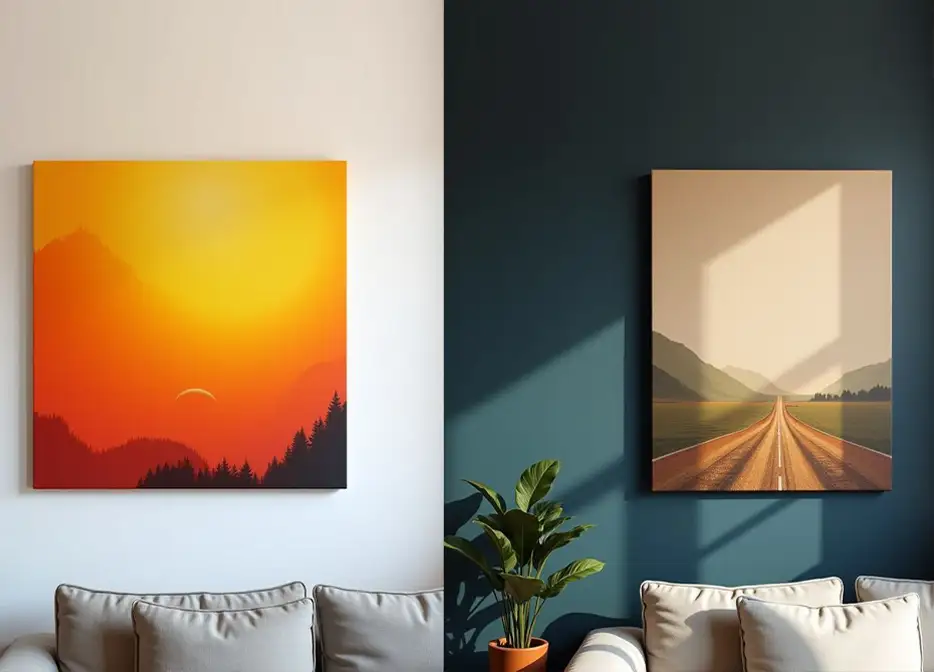
On the other hand, canvas prints have a more classic, textured appearance that brings a cozy, timeless feel. The natural texture of canvas gives images a soft, painterly effect, blending well in traditional, rustic, or cozy settings. Canvas prints add warmth, inviting viewers to appreciate the art’s depth and subtle details.
Color and Clarity
- Color Vibrancy: Acrylic prints excel in color intensity, making hues appear bold and dynamic. The glossy finish acts almost like a magnifying glass, enhancing each color for a rich, eye-catching display.
- Subtle Tones: Canvas prints display colors in a softer, more muted way, offering a calming effect. This subtlety complements varied decor styles, giving photos and artwork a gentle, classic look.
Texture Differences
The smooth surface of acrylic provides a crisp, clean image with no visible texture, ideal for sharp details and high-definition photos. With its woven texture, canvas adds an artistic quality to images, making them feel like original works of art on display.
Lighting Effects
- Acrylic: Highly reflective, which can lead to glare in direct light but enhances colors with controlled lighting. Works well with spotlights to bring out vibrant details.
- Canvas: Minimal glare, making it versatile for various lighting conditions. It maintains visual quality under both natural and artificial lighting without distracting reflections.
Viewing Angles
- Acrylic: Best viewed straight-on for maximum clarity and depth.
- Canvas: The textured surface minimizes reflections, so it looks good from multiple angles and adapts easily to different spaces and layouts.
Acrylic and canvas prints each have unique strengths in color, texture, and visual impact. Choose the style that best suits your space’s mood and lighting.
Cost Comparison
Price Ranges by Size
Acrylic prints are generally more expensive due to material costs, especially for larger formats. Canvas prints offer a more budget-friendly option but may require additional fees for high-quality materials and printing.

Additional Costs
- Acrylic: May include extra fees for face-mounting, framing, and thicker sheets.
- Canvas: Optional framing costs and stretching are often needed.
Long-Term Investment
For a durable, long-lasting option, acrylic prints offer better value despite higher initial costs, as they maintain their quality longer than canvas.
| Aspect | Acrylic Prints | Canvas Prints |
| Initial Cost | Higher | Lower |
| Price Range | $100 – $500+ | $50 – $200+ |
| Size Impact | Larger sizes cost more | Less price increase with size |
| Long-term Value | Better durability justifies cost | May need replacement sooner |
Size, Weight & Thickness Differences
Acrylic and canvas prints differ in their physical characteristics. These differences affect how they’re displayed and handled.
| Characteristic | Acrylic Prints | Canvas Prints |
| Weight | Heavier | Lighter |
| Size Options | Limited to smaller sizes | Available in larger sizes |
| Thickness | Thinner (1/4 inch) | Thicker (1.5 inches) |
| Display Impact | Modern, sleek look | Traditional, textured appearance |
Acrylic prints weigh more due to their glass-like material. Canvas prints are lighter, making them easier to hang.
Size options vary between the two. Acrylic prints often come in smaller sizes, while canvas prints offer larger options for big walls.
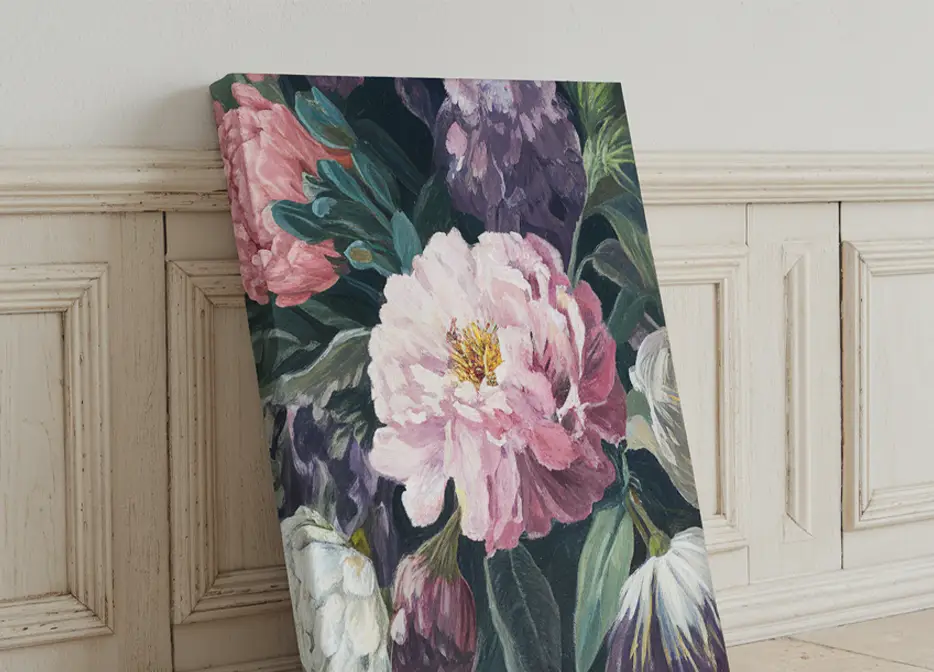
Thickness also differs. Acrylic prints are typically 1/4 inch thick, while canvas prints are usually 1.5 inches thick. These traits affect the overall look of each print type; acrylic prints give a modern, sleek appearance, while canvas prints offer a more traditional, textured look.
Evaluating Durability
Acrylic and canvas prints have different levels of durability. Acrylic prints resist fading and scratches better than canvas prints.

Longevity and Wear Resistance
When it comes to durability, acrylic prints offer superior longevity. The hard, glossy acrylic surface resists fading and scratches, keeping images vivid for years. This protective layer makes acrylic a better choice in high-traffic areas or spaces prone to wear.
Canvas prints, while durable, are more susceptible to damage. They can tear, sag over time, or even yellow without proper treatment, especially if exposed to direct sunlight.
Environmental Suitability
Acrylic prints handle different environments with ease, particularly moisture and sunlight. Their resistance to humidity makes them ideal for bathrooms or bright spaces where canvas might fade or warp over time.
Additionally, acrylic’s smooth surface resists dust and is easy to clean, unlike canvas, which requires gentle dusting to avoid dust accumulation in the textured fabric.
Outdoor Use
Acrylic prints are a solid choice for outdoor or semi-outdoor areas like patios. They withstand temperature shifts and moisture far better than canvas, making them a solid choice if you’re looking for art that can withstand the elements.
Hanging and Framing Differences
Acrylic and canvas prints each have unique hanging and framing options that can influence your space’s overall presentation and aesthetic. Here’s how each type differs in mounting, framing, and visual impact.
Acrylic prints usually come ready to hang with mounting blocks or French cleats for easy installation.
They don’t need frames, offering a sleek, frameless look that suits modern spaces. You can also use standoff bolts to create a floating effect, adding depth. Acrylic prints are lightweight, making them easier to hang on most walls.
Conversely, canvas prints arrive stretched over a wooden frame (gallery wrap) and can be hung directly on the wall.
Further Reading: How to Hang Acrylic Wall Art: A Comprehensive Installation Guide
Canvas prints offer versatile framing options, allowing you to choose frames to match traditional or contemporary decor. However, they tend to be heavier and require sturdy wall anchors. They’re typically hung with D-rings or wire.
Wall Impact
Acrylic prints stand out from the wall, adding dimension to a room, while canvas prints sit closer to the wall, blending seamlessly with the surrounding decor.
Framing Choices and Display Flexibility
Acrylic prints rarely need frames, keeping costs low, while canvas prints offer more framing options for added style.
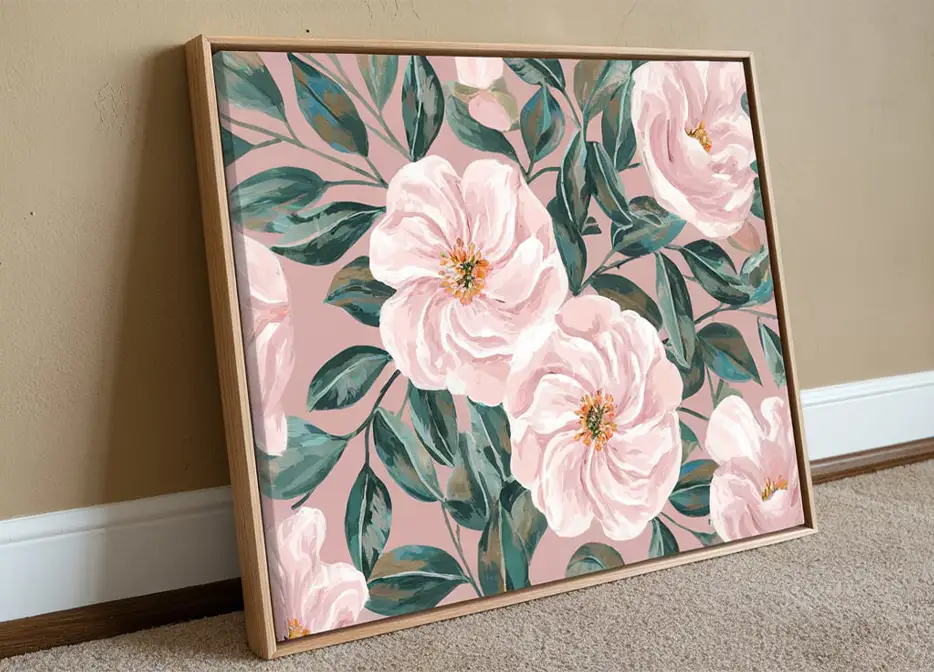
Acrylics work well in minimalist spaces, whereas canvas prints adapt to both modern and classic settings. Both can be arranged in gallery-style displays for a curated look.
Best Applications
Acrylic Prints Best For
- Ideal Environments: Offices, modern homes, galleries.
- Photo Types: High-definition photos, abstract images, vibrant colors.
- Design Styles: Minimalist, contemporary.
- Room Considerations: High-traffic areas where durability is key.
Canvas Prints Best For
- Suitable Spaces: Living rooms, cozy spaces, children’s rooms.
- Image Types: Landscapes, classic artwork.
- Décor Styles: Rustic, traditional, eclectic.
- Location Factors: Low-traffic or private spaces to minimize wear.
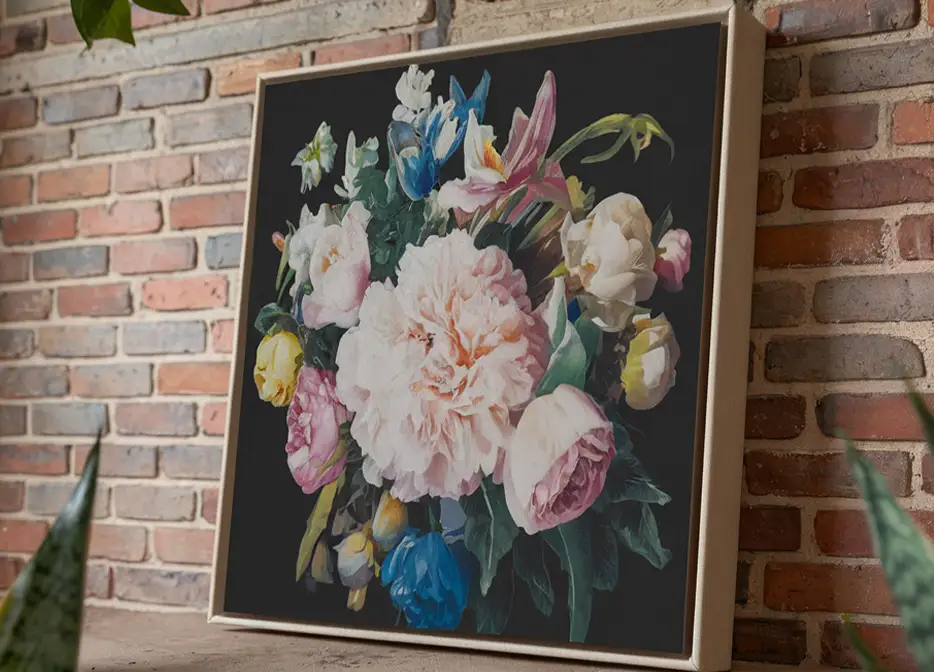
Cleaning and Maintenance
Acrylic Prints
Clean with a soft, lint-free cloth to avoid scratches. Acrylic prints are resistant to moisture, so light cleaning is simple.
Canvas Prints
Avoid water; instead, dust gently with a dry cloth. Store away from direct sunlight to prevent fading.
Making Your Decision
Choosing between acrylic and canvas prints depends on your unique needs, style, and budget. Here’s a simple guide to help you decide:

Selection Criteria
- Budget: Canvas prints are often more affordable, while acrylic prints offer a high-end look at a higher price point.
- Environment: Acrylic is moisture-resistant, perfect for bathrooms or bright rooms, while canvas fits well in lower-light areas and dry spaces.
- Décor Style: Acrylic suits modern, minimalist interiors, while canvas provides a classic or rustic touch.
Environment Assessment
Consider where you’ll display the print. Acrylic’s durability and glare-resistant options might be best in a high-traffic or bright room. Canvas offers a warm, textured appeal for cozy, intimate spaces.
Style Matching
Acrylic’s bold colors and glossy finish match contemporary spaces, while canvas softens the look of photographs and art, ideal for traditional settings.
Purchase Recommendations
Go with acrylic for a sleek, long-lasting display. Canvas could be the right choice for a budget-friendly, timeless feel. Consider maintenance: Acrylic is easier to clean, while canvas needs gentle dusting.
Conclusion
Both acrylic and canvas prints have unique advantages that fit different preferences, budgets, and decor styles. Acrylic prints deliver a high-impact, contemporary look, while canvas prints bring warmth and charm with a traditional touch.
Further Reading

